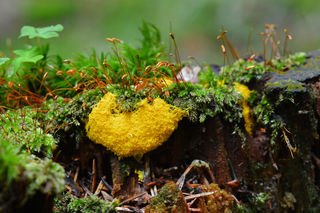Coronavirus Disease 2019
Slime Mold Shows Us How to Survive the COVID-19 Pandemic
Lower-level organisms sometimes show higher-level wisdom.
Posted March 20, 2020

For sure, the COVID-19 illness, if you get it, can be painful, scary, and even life-threatening. Hopefully, most of us will not get it. Equally and sometimes even more painful and frightening, many, many of us are suffering economic repercussions from the pandemic.
Without making light of any of these challenges, I do want nonetheless to talk here about an upside behavior change that a lowly organism called slime mold has learned to do to survive and even thrive in hard times.
In good times, each slime mold cell functions individually. When drought or other dangers occur, nearby molds suddenly clump into a colony. What had been many individual units suddenly becomes one united organism. Amazing. And high in survival value.
As a PBS special explains, "Slime mold is not a plant or animal. It’s not a fungus, though it sometimes resembles one. Slime mold, in fact, is a soil-dwelling amoeba, a brainless, single-celled organ." Quoting Frederick Spiegel, a biology professor at the University of Arkansas, the explanation continues: "When all is well, the slime mold thrives as a single-celled organism, but when food is scarce, it combines forces with its brethren, and grows. Starving amoebas work in tandem, signaling to each other to join and form a multicellular mass, like a moving sausage.”
Now, in response to the threat of the coronavirus pandemic, human beings are glomming together.
Families are spending far more time together. I hear stories from all over of kids and parents all having fun together. They are doing projects, parents are teaching kids to cook, parents and kids are watching funny moves together, and many are loving it. I personally for the first time have taken time to play violin-piano duets with one grandson, talk about the new potential girlfriend with another, hang out and listen to the latest songs an older one has learned, discovered the intricacies of ancient history from a college grandchild now studying from home, and together we've all been peeling carrots and potatoes and learning to make yummy onion soup.
Long-distance friends and family members suddenly are talking more, using electronic means like Zoom and Skype and WhatsApp to stay more closely in touch. I hear too of all kinds of neighbors meeting together, talking, and helping each other out in ways that never happened before.
On the street where I live, we and our neighbors will be joining each other this evening for a neighborhood singing session—with six feet between our bodies but stronger than ever connections between our souls.
The joining-together trend is global.
There's been singing from the balconies in Italy.
Last night in Israel, throughout the whole country at 6:00 p.m., residents went out onto their front yards and apartment balconies to clap a resounding round of applause for the health care workers risking their lives to save others.
Just like slime mold, so many of us are forgetting what divides us and coming together! Maybe this is just what our country has been needing.
Can we now overcome the spirit of divisiveness that has plagued America's political life of late? Can we begin again to appreciate how fortunate we are to have each other, this amazing country, and the glorious global world in which we live?


